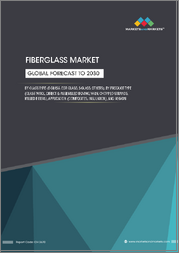
|
시장보고서
상품코드
1563080
세계의 양모 원사 시장 : 산업 분석, 규모, 점유율, 성장, 동향 및 예측(2024-2031년)Wool Yarn Market: Global Industry Analysis, Size, Share, Growth, Trends, and Forecast, 2024-2031 |
||||||
Persistence Market Research는 최근 세계 양모 원사 시장에 대한 종합적인 보고서를 발표하여 시장 성장 촉진요인, 동향, 기회, 과제 등 주요 시장 역학에 대한 상세한 분석을 제공했습니다. 이 상세한 보고서는 시장 구조와 예측 기간 동안의 성장 잠재력을 조명합니다.
주요 인사이트
- 양모 원사 시장 규모(2024E) : 57억 6,000만 달러
- 예상 시장 규모(2031년) : 75억 2,000만 달러
- 세계 시장 성장률(2024-2031년 CAGR) : 3.9%
양모 원사 시장 - 조사 범위:
양모 원사는 양모 섬유로 만든 원사의 일종으로 보온성, 내구성, 다용도성으로 널리 알려져 있습니다. 의류, 직물, 실내 장식, 공예품 등 다양한 용도로 사용됩니다. 지속 가능한 천연섬유에 대한 수요 증가, 손뜨개질 및 수공예 활동 증가, 친환경 제품에 대한 선호도 증가가 시장을 주도하고 있습니다.
시장 성장 촉진요인:
세계 양모 원사 시장의 성장을 주도하는 몇 가지 주요 요인이 있습니다. 환경 문제에 대한 우려로 인해 지속 가능한 소재와 유기농 소재에 대한 소비자의 선호도가 높아진 것이 주요 요인으로 작용하고 있습니다. 또한, 뜨개질과 크로셰 뜨개질과 같은 전통 공예의 부활이 시장 수요를 촉진하고 있습니다. 의류 및 액티브웨어의 고기능성 소재로서 양모의 인기가 높아지면서 양모 원사 시장의 성장을 더욱 촉진하고 있습니다.
시장 성장 억제요인 :
양모 원사 시장은 성장 잠재력에도 불구하고 몇 가지 문제에 직면해 있습니다. 시장 변동으로 인한 양모 가격의 변동은 제조 비용과 가격 전략에 영향을 미칠 수 있습니다. 또한 합성 섬유 및 대체 소재와의 경쟁은 양모 시장 점유율을 제한할 수 있습니다. 또한 양모 생산이 환경에 미치는 영향과 동물 복지에 대한 우려도 시장 관계자들에게 도전이 될 수 있습니다.
시장 기회 :
모직 원사 시장은 특히 혁신적인 제품과 지속 가능한 방법의 개발에서 큰 성장 기회를 제공합니다. 패션에서 커스터마이징과 개인화 트렌드 증가는 양모 원사의 용도에 새로운 길을 열어주고 있습니다. 원사 제조업체와 패션 디자이너의 협업은 혁신을 촉진하고 시장을 확대할 수 있습니다. 또한, 친환경 및 유기농 제품에 대한 수요 증가는 지속 가능한 조달 및 생산 방식에 중점을 둔 기업에게 기회가 될 수 있습니다.
본 보고서에서 다룬 주요 질문들
- 세계 양모 원사 시장을 이끄는 주요 요인은?
- 모사 수요가 가장 높은 지역은 어디이며, 이러한 성장에 영향을 미치는 추세는 무엇인가?
- 섬유 기술의 발전은 경쟁 구도에 어떤 영향을 미쳤는가?
- 양모 원사 시장의 주요 업체는 누구이며, 시장 지위를 유지하기 위해 어떤 전략을 시행하고 있는가?
- 세계 양모 원사 시장의 새로운 트렌드와 전망은?
목차
제1장 주요 요약
제2장 시장 개요
- 시장 분류
- 시장의 정의
제3장 주요 시장 동향
제4장 중요 성공 요인
- 제품 채택/사용 상황 분석
- 제품 USP/특징
- 전략적 프로모션 전략
제5장 세계의 양모 원사 시장 수요 분석
- 시장 수량 분석, 2019-2023년
- 시장 수량 예측, 2024-2031년
- 전년대비 성장 동향 분석
제6장 세계의 양모 원사 시장 - 가격 분석
- 실 유형별 지역별 가격 분석
- 가격 분석
- 세계 평균 가격 분석 벤치마크
제7장 세계의 양모 원사 시장 수요(금액 및 규모) 분석
- 시장 매출 분석, 2019-2023년
- 시장 매출 예측, 2024-2031년
- 전년대비 성장 동향 분석
- 절대적 매출 기회
제8장 시장 배경
- 거시경제 요인
- 예측 요인 - 관련성과 영향
- 밸류체인
- 시장 역학
제9장 세계의 양모 원사 시장 분석 : 연사 유형별
- 서론/주요 조사 결과
- 시장 규모(금액 및 수량) 분석, 2019-2023년
- 시장 규모(금액 및 수량) 분석 및 예측, 2024-2031년
- Worsted
- Woolen
- 시장의 매력 분석
제10장 세계의 양모 원사 시장 분석 : 울 유형별
- 서론/주요 조사 결과
- 시장 규모(금액 및 수량) 분석, 2019-2023년
- 시장 규모(금액 및 수량) 분석 및 예측, 2024-2031년
- Merino Wool
- Peruvian Highland Wool
- Teeswater Wool
- Shetland Wool
- Cashmere Wool
- 기타
- 시장의 매력 분석
제11장 세계의 양모 원사 시장 분석 : 용도별
- 서론/주요 조사 결과
- 시장 규모(금액 및 수량) 분석, 2019-2023년
- 시장 규모(금액 및 수량) 분석 및 예측, 2024-2031년
- 의류
- 스포츠
- 블레이저 코트
- 재킷
- 기타
- 실내장식용 패브릭
- 블랭킷
- 바닥재
- 기타
- 의류
- 시장의 매력 분석
제12장 세계의 양모 원사 시장 분석 : 지역별
- 서론
- 시장 규모(금액 및 수량) 분석, 2019-2023년
- 시장 규모(금액 및 수량) 분석 및 예측, 2024-2031년
- 북미
- 라틴아메리카
- 유럽
- 남아시아
- 동아시아
- 오세아니아
- 중동 및 아프리카
- 시장의 매력 분석
제13장 북미 양모 원사 시장 분석
제14장 라틴아메리카 양모 원사 시장 분석
제15장 유럽 양모 원사 시장 분석
제16장 남아시아 양모 원사 시장 분석
제17장 동아시아 양모 원사 시장 분석
제18장 오세아니아 양모 원사 시장 분석
제19장 중동 및 아프리카 양모 원사 시장 분석
제20장 신흥 국가 양모 원사 시장 분석
- 서론
- 주요 국가별 시장 매출 비율 분석
- 세계와 국가별 성장 비교
- 중국 양모 원사 시장 분석
- 인도 양모 원사 시장 분석
- 방글라데시 양모 원사 시장 분석
제21장 시장 구조 분석
- 기업 Tier별 시장 분석(양모 원사)
- 시장 집중
- 주요 기업의 시장 점유율 분석
제22장 경쟁 분석
- 경쟁 대시보드
- 경쟁 벤치마킹
- 경쟁 상세
- The Woolmark Company
- Indorama Ventures Public Company Limited
- Ortovox
- HTX-Shanghai Huaxiang Woolen Co.,Ltd.
- Wool Yarns of New Zealand
- American Woolen Company
- Sudwolle Group
- John Marshall &Company(Joma)
- Shandong Hengtai Textile Co. Ltd
- Henan First Textile &Apparel(Group) Co. Ltd.
- Shanghai Charmkey Textile Co.,Ltd
- Ferney Spinning Mills Limited
- Rosy Woollen Mills Pvt. Ltd.
- Sharman Woolen Mills Ltd
- KentWool
- Geetanjali Woolens
- Lawton Yarns
- Shanghai Token Cashmere Co.,Ltd
- Jayashree Textiles
제23장 사용된 전제조건과 두자어
제24장 조사 방법
LSH 24.10.18Persistence Market Research has recently released a comprehensive report on the global Wool Yarn Market, providing an in-depth analysis of key market dynamics, including drivers, trends, opportunities, and challenges. This detailed report sheds light on the market structure and growth potential over the forecast period.
Key Insights:
- Wool Yarn Market Size (2024E): US$ 5.76 billion
- Projected Market Value (2031F): US$ 7.52 billion
- Global Market Growth Rate (CAGR 2024 to 2031): 3.9%
Wool Yarn Market - Report Scope:
Wool yarn is a type of yarn made from the fibers of sheep's wool, widely known for its warmth, durability, and versatility. It is used in various applications, including clothing, textiles, home decor, and crafts. The market is driven by increasing demand for sustainable and natural fibers, the rise in hand-knitting and crafting activities, and a growing trend towards eco-friendly products.
Market Growth Drivers:
Several key factors are driving the growth of the global Wool Yarn Market. The rising consumer preference for sustainable and organic materials due to environmental concerns is a significant contributor. Additionally, the resurgence of traditional crafts, such as knitting and crocheting, is fueling market demand. The increasing popularity of wool as a high-performance material in apparel and activewear further supports the growth of the wool yarn market.
Market Restraints:
Despite its growth potential, the Wool Yarn Market faces several challenges. Fluctuating wool prices due to market volatility can impact manufacturing costs and pricing strategies. Moreover, competition from synthetic fibers and alternative materials may limit wool's market share. The environmental impact of wool production and concerns regarding animal welfare can also pose challenges for market players.
Market Opportunities:
The Wool Yarn Market presents substantial growth opportunities, particularly in the development of innovative products and sustainable practices. The growing trend towards customization and personalization in fashion is creating new avenues for wool yarn applications. Collaborations between yarn manufacturers and fashion designers can drive innovation and expand market reach. Additionally, the rising demand for eco-friendly and organic products offers opportunities for companies focusing on sustainable sourcing and production methods.
Key Questions Answered in the Report:
- What are the primary factors driving the global Wool Yarn Market?
- Which regions are witnessing the highest demand for wool yarn, and what trends are influencing this growth?
- How are advancements in textile technology impacting the competitive landscape?
- Who are the leading players in the Wool Yarn Market, and what strategies are they implementing to maintain their market positions?
- What are the emerging trends and future prospects in the global Wool Yarn Market?
Competitive Intelligence and Business Strategy:
Leading players in the Wool Yarn Market, including companies like The Woolmark Company, Lang Yarns, and Rowan Yarns, are focusing on innovation, sustainable practices, and strategic partnerships to strengthen their market positions. These companies are investing in the development of high-quality and sustainable wool yarn products, enhancing their distribution networks, and targeting niche markets. Collaborations with fashion brands, retailers, and eco-conscious organizations are crucial for market penetration and sustained growth. Ensuring compliance with ethical sourcing standards and addressing consumer concerns will help these companies maintain a competitive edge and achieve long-term success in the Wool Yarn Market.
Key Companies Profiled:
- The Woolmark Company
- Indorama Ventures Public Company Limited
- Ortovox
- HTX- Shanghai Huaxiang Woolen Co.,Ltd.
- Wool Yarns of New Zealand
- American Woolen Company
- Sudwolle Group
- John Marshall & Company (Joma)
- Shandong Hengtai Textile Co. Ltd
- Henan First Textile & Apparel (Group) Co. Ltd.
- Shanghai Charmkey Textile Co.,Ltd
- Ferney Spinning Mills Limited
- Rosy Woollen Mills Pvt. Ltd.
- Sharman Woolen Mills Ltd
- KentWool
- Geetanjali Woolens
- Lawton Yarns
- Shanghai Token Cashmere Co.,Ltd
- Jayashree Textiles
Key Segments of the Wool Yarn Market
Yarn Type
- Worsted
- Woolen
Wool Type
- Merino Wool
- Peruvian Highland Wool
- Teeswater Wool
- Shetland Wool
- Cashmere Wool
Application
- Apparel
- Upholstery Fabrics
- Blankets
- Flooring
Region
- North America
- Latin America
- Europe
- East Asia
- South Asia
- Oceania
- Middle East and Africa (MEA)
Table of Contents
1. Executive Summary
- 1.1. Global Market Outlook
- 1.2. Demand Side Trends
- 1.3. Supply Side Trends
- 1.4. Analysis and Recommendations
2. Market Overview
- 2.1. Market Taxonomy
- 2.2. Market Definition
3. Key Market Trends
4. Key Success Factors
- 4.1. Product Adoption / Usage Analysis
- 4.2. Product USPs / Features
- 4.3. Strategic Promotional Strategies
5. Global Wool Yarn MarketDemand Analysis 2019-2023 and Forecast, 2024-2031
- 5.1. Historical Market Volume (Tons) Analysis, 2019-2023
- 5.2. Current and Future Market Volume Projections, 2024-2031
- 5.3. Y-o-Y Growth Trend Analysis
6. Global Wool Yarn Market - Pricing Analysis
- 6.1. Regional Pricing Analysis By Yarn Type
- 6.2. Pricing Break-up
- 6.3. Global Average Pricing Analysis Benchmark
7. Global Wool Yarn Market Demand (in Value or Size in US$ Bn) Analysis 2019-2023 and Forecast, 2024-2031
- 7.1. Historical Market Value (US$ Bn) Analysis, 2019-2023
- 7.2. Current and Future Market Value (US$ Bn) Projections, 2024-2031
- 7.2.1. Y-o-Y Growth Trend Analysis
- 7.2.2. Absolute $ Opportunity Analysis
8. Market Background
- 8.1. Macro-Economic Factors
- 8.1.1. Global GDP Growth Outlook
- 8.1.2. Global Industry Value Added
- 8.1.3. Textile Industry Overview
- 8.1.4. Textile & Clothing Industry Trade
- 8.1.5. Global Fiber Market Overview
- 8.1.6. Global Fabric Market Overview
- 8.2. Forecast Factors - Relevance & Impact
- 8.3. Value Chain
- 8.4. Market Dynamics
- 8.4.1. Drivers
- 8.4.2. Restraints
- 8.4.3. Opportunity Analysis
9. Global Wool Yarn Market Analysis 2019-2023 and Forecast 2024-2031, by Yarn Type
- 9.1. Introduction / Key Findings
- 9.2. Historical Market Size (US$ Bn) and Volume Analysis By Yarn Type, 2019-2023
- 9.3. Current and Future Market Size (US$ Bn) and Volume Analysis and Forecast By Yarn Type, 2024-2031
- 9.3.1. Worsted
- 9.3.2. Woolen
- 9.4. Market Attractiveness Analysis By Yarn Type
10. Global Wool Yarn Market Analysis 2019-2023 and Forecast 2024-2031, By Wool Type
- 10.1. Introduction / Key Findings
- 10.2. Historical Market Size (US$ Bn) and Volume Analysis By Wool Type, 2019-2023
- 10.3. Current and Future Market Size (US$ Bn) and Volume Analysis and Forecast By Wool Type, 2024-2031
- 10.3.1. Merino Wool
- 10.3.2. Peruvian Highland Wool
- 10.3.3. Teeswater Wool
- 10.3.4. Shetland Wool
- 10.3.5. Cashmere Wool
- 10.3.6. Others
- 10.4. Market Attractiveness Analysis By Wool Type
11. Global Wool Yarn Market Analysis 2019-2023 and Forecast 2024-2031, by Application
- 11.1. Introduction / Key Findings
- 11.2. Historical Market Size (US$ Bn) and Volume Analysis By Application, 2019-2023
- 11.3. Current and Future Market Size (US$ Bn) and Volume Analysis and Forecast By Application, 2024-2031
- 11.3.1. Apparel
- 11.3.1.1. Sports
- 11.3.1.2. Blazers
- 11.3.1.3. Jacketing
- 11.3.1.4. Others
- 11.3.2. Upholstery Fabric
- 11.3.3. Blanket
- 11.3.4. Flooring
- 11.3.5. Others
- 11.3.1. Apparel
- 11.4. Market Attractiveness Analysis By Application
12. Global Wool Yarn Market Analysis 2019-2023 and Forecast 2024-2031, by Region
- 12.1. Introduction
- 12.2. Historical Market Size (US$ Bn) and Volume Analysis By Region, 2019-2023
- 12.3. Current Market Size (US$ Bn) and Volume Analysis and Forecast By Region, 2024-2031
- 12.3.1. North America
- 12.3.2. Latin America
- 12.3.3. Europe
- 12.3.4. South Asia
- 12.3.5. East Asia
- 12.3.6. Oceania
- 12.3.7. Middle East & Africa
- 12.4. Market Attractiveness Analysis By Region
13. North America Wool Yarn Market Analysis 2019-2023 and Forecast 2024-2031
- 13.1. Introduction
- 13.2. Historical Market Size (US$ Bn) and Volume Trend Analysis By Market Taxonomy, 2019-2023
- 13.3. Market Size (US$ Bn) and Volume Forecast By Market Taxonomy, 2024-2031
- 13.3.1. By Country
- 13.3.1.1. U.S.
- 13.3.1.2. Canada
- 13.3.2. By Yarn Type
- 13.3.3. By Wool Type
- 13.3.4. By Application
- 13.3.1. By Country
- 13.4. Market Attractiveness Analysis
- 13.4.1. By Country
- 13.4.2. By Yarn Type
- 13.4.3. By Wool Type
- 13.4.4. By Application
- 13.5. Key Market Participants - Intensity Mapping
14. Latin America Wool Yarn Market Analysis 2019-2023 and Forecast 2024-2031
- 14.1. Introduction
- 14.2. Historical Market Size (US$ Bn) and Volume Trend Analysis By Market Taxonomy, 2019-2023
- 14.3. Market Size (US$ Bn) and Volume Forecast By Market Taxonomy, 2024-2031
- 14.3.1. By Country
- 14.3.1.1. Brazil
- 14.3.1.2. Mexico
- 14.3.1.3. Rest of Latin America
- 14.3.2. By Yarn Type
- 14.3.3. By Wool Type
- 14.3.4. By Application
- 14.3.1. By Country
- 14.4. Market Attractiveness Analysis
- 14.4.1. By Country
- 14.4.2. By Yarn Type
- 14.4.3. By Wool Type
- 14.4.4. By Application
- 14.5. Key Market Participants - Intensity Mapping
15. Europe Wool Yarn Market Analysis 2019-2023 and Forecast 2024-2031
- 15.1. Introduction
- 15.2. Historical Market Size (US$ Bn) and Volume Trend Analysis By Market Taxonomy, 2019-2023
- 15.3. Market Size (US$ Bn) and Volume Forecast By Market Taxonomy, 2024-2031
- 15.3.1. By Country
- 15.3.1.1. Germany
- 15.3.1.2. Italy
- 15.3.1.3. France
- 15.3.1.4. U.K.
- 15.3.1.5. Spain
- 15.3.1.6. BENELUX
- 15.3.1.7. Russia
- 15.3.1.8. Rest of Europe
- 15.3.2. By Yarn Type
- 15.3.3. By Wool Type
- 15.3.4. By Application
- 15.3.1. By Country
- 15.4. Market Attractiveness Analysis
- 15.4.1. By Country
- 15.4.2. By Yarn Type
- 15.4.3. By Wool Type
- 15.4.4. By Application
- 15.5. Key Market Participants - Intensity Mapping
16. South Asia Wool Yarn Market Analysis 2019-2023 and Forecast 2024-2031
- 16.1. Introduction
- 16.2. Historical Market Size (US$ Bn) and Volume Trend Analysis By Market Taxonomy, 2019-2023
- 16.3. Market Size (US$ Bn) and Volume Forecast By Market Taxonomy, 2024-2031
- 16.3.1. By Country
- 16.3.1.1. India
- 16.3.1.2. Thailand
- 16.3.1.3. Indonesia
- 16.3.1.4. Malaysia
- 16.3.1.5. Rest of South Asia
- 16.3.2. By Yarn Type
- 16.3.3. By Wool Type
- 16.3.4. By Application
- 16.3.1. By Country
- 16.4. Market Attractiveness Analysis
- 16.4.1. By Country
- 16.4.2. By Yarn Type
- 16.4.3. By Wool Type
- 16.4.4. By Application
- 16.5. Key Market Participants - Intensity Mapping
17. East Asia Wool Yarn Market Analysis 2019-2023 and Forecast 2024-2031
- 17.1. Introduction
- 17.2. Historical Market Size (US$ Bn) and Volume Trend Analysis By Market Taxonomy, 2019-2023
- 17.3. Market Size (US$ Bn) and Volume Forecast By Market Taxonomy, 2024-2031
- 17.3.1. By Country
- 17.3.1.1. Mainland China
- 17.3.1.2. Taiwan
- 17.3.1.3. Hong Kong
- 17.3.1.4. Japan
- 17.3.1.5. South Korea
- 17.3.2. By Yarn Type
- 17.3.3. By Wool Type
- 17.3.4. By Application
- 17.3.1. By Country
- 17.4. Market Attractiveness Analysis
- 17.4.1. By Country
- 17.4.2. By Yarn Type
- 17.4.3. By Wool Type
- 17.4.4. By Application
- 17.5. Key Market Participants - Intensity Mapping
18. Oceania Wool Yarn Market Analysis 2019-2023 and Forecast 2024-2031
- 18.1. Introduction
- 18.2. Historical Market Size (US$ Bn) and Volume Trend Analysis By Market Taxonomy, 2019-2023
- 18.3. Market Size (US$ Bn) and Volume Forecast By Market Taxonomy, 2024-2031
- 18.3.1. By Country
- 18.3.1.1. Australia
- 18.3.1.2. New Zealand
- 18.3.2. By Yarn Type
- 18.3.3. By Wool Type
- 18.3.4. By Application
- 18.3.1. By Country
- 18.4. Market Attractiveness Analysis
- 18.4.1. By Country
- 18.4.2. By Yarn Type
- 18.4.3. By Wool Type
- 18.4.4. By Application
- 18.5. Key Market Participants - Intensity Mapping
19. Middle East and Africa Wool Yarn Market Analysis 2019-2023 and Forecast 2024-2031
- 19.1. Introduction
- 19.2. Historical Market Size (US$ Bn) and Volume Trend Analysis By Market Taxonomy, 2019-2023
- 19.3. Market Size (US$ Bn) and Volume Forecast By Market Taxonomy, 2024-2031
- 19.3.1. By Country
- 19.3.1.1. GCC Countries
- 19.3.1.2. Northern Africa
- 19.3.1.3. Turkey
- 19.3.1.4. South Africa
- 19.3.1.5. Rest of Middle East and Africa
- 19.3.2. By Yarn Type
- 19.3.3. By Wool Type
- 19.3.4. By Application
- 19.3.1. By Country
- 19.4. Market Attractiveness Analysis
- 19.4.1. By Country
- 19.4.2. By Yarn Type
- 19.4.3. By Wool Type
- 19.4.4. By Application
- 19.5. Key Market Participants - Intensity Mapping
20. Emerging Countries Wool Yarn Market Analysis 2019-2023 and Forecast 2024-2031
- 20.1. Introduction
- 20.1.1. Market Value Proportion Analysis, By Key Countries
- 20.1.2. Global Vs. Country Growth Comparison
- 20.2. China Wool Yarn Market Analysis
- 20.2.1. Introduction
- 20.2.2. PEST Analysis
- 20.2.3. Market Value Proportion Analysis by Market Taxonomy
- 20.2.4. Market Volume and Value (US$ Bn) Analysis and Forecast by Market Taxonomy
- 20.2.4.1. By Yarn Type
- 20.2.4.2. By Wool Type
- 20.2.4.3. By Application
- 20.3. India Wool Yarn Market Analysis
- 20.3.1. Introduction
- 20.3.2. PEST Analysis
- 20.3.3. Market Value Proportion Analysis by Market Taxonomy
- 20.3.4. Market Volume and Value (US$ Bn) Analysis and Forecast by Market Taxonomy
- 20.3.4.1. By Yarn Type
- 20.3.4.2. By Wool Type
- 20.3.4.3. By Application
- 20.4. Bangladesh Wool Yarn Market Analysis
- 20.4.1. Introduction
- 20.4.2. PEST Analysis
- 20.4.3. Market Value Proportion Analysis by Market Taxonomy
- 20.4.4. Market Volume and Value (US$ Bn) Analysis and Forecast by Market Taxonomy
- 20.4.4.1. By Yarn Type
- 20.4.4.2. By Wool Type
- 20.4.4.3. By Application
21. Market Structure Analysis
- 21.1. Market Analysis by Tier of Companies (Wool Yarn)
- 21.2. Market Concentration
- 21.3. Market Share Analysis of Top Players
22. Competition Analysis
- 22.1. Competition Dashboard
- 22.2. Competition Benchmarking
- 22.3. Competition Deep Dive
- 22.3.1. The Woolmark Company
- 22.3.2. Indorama Ventures Public Company Limited
- 22.3.3. Ortovox
- 22.3.4. HTX- Shanghai Huaxiang Woolen Co.,Ltd.
- 22.3.5. Wool Yarns of New Zealand
- 22.3.6. American Woolen Company
- 22.3.7. Sudwolle Group
- 22.3.8. John Marshall & Company (Joma)
- 22.3.9. Shandong Hengtai Textile Co. Ltd
- 22.3.10. Henan First Textile & Apparel (Group) Co. Ltd.
- 22.3.11. Shanghai Charmkey Textile Co.,Ltd
- 22.3.12. Ferney Spinning Mills Limited
- 22.3.13. Rosy Woollen Mills Pvt. Ltd.
- 22.3.14. Sharman Woolen Mills Ltd
- 22.3.15. KentWool
- 22.3.16. Geetanjali Woolens
- 22.3.17. Lawton Yarns
- 22.3.18. Shanghai Token Cashmere Co.,Ltd
- 22.3.19. Jayashree Textiles



















